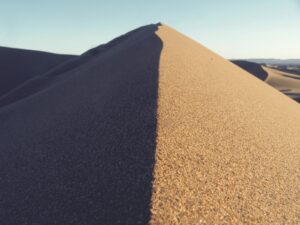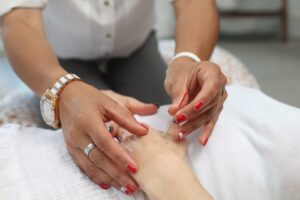Subscribe to the Newsletter
If you are interested in understanding how Traditional Chinese Medicine can improve your life sign up to my newsletter for the latest updates.

Element points lie between elbow and finger-tip or knee and toe-tip. They hugely enhance other acupuncture strategies.
Warning! This page is rather abstract, and is here really only for reference. If you’re new to all this stuff, don’t start here! Click here perhaps for something more digestible.
Although so distal from problems in the head and body, for thousands of years experience has shown their importance for health.
One school of acupuncture, the Five Elements school, emphasises them in both diagnosis and treatment. However, the way they use and recognise their importance is very different to that in modern TCM Theory.
In Five Element thinking the element point is identified and used variously according to the
In other forms of acupuncture and depending on the training of the practitioner, point-use depends on one or more of the following:
So there is some overlap, but in Five Elements theory any of the element points may be equally relevant, whereas in modern general acupuncture some points are hardly or seldom used. For example, jing-well points, those at the extreme ends of the channels on either fingertips or toes, are used more often in Five Element treatment.
Also, the needle size is usually different, and so is the acupuncture technique, being much more elaborated in general acupuncture theory. Five element practitioners typically use fewer and thinner needles and a very simple needle technique.
Another way of understanding and using the Element points comes from Transport point theory.
Although referring to exactly the same points listed below, each is regarded as having a specific purpose which depends on its position in the channel starting distally and reaching proximally to knee or elbow.
The tables below also include the Luo-connecting or ‘junction’ points for each channel although, strictly speaking, they are not element points.
In Yin channels the Earth point is also the channel’s source point.
For Yang channels, the source points are listed in the left-hand column.
If the point is not in red, indicating a link to a fuller description, we have not yet written a page on that point. (Or maybe we’ve written it but forgotten to put a link to it!)
| Wood | Fire | Earth/Source point | Metal | Water | Luo | |
| Liver | Liv 1 Dadun | Liv 2 Xingjian | Liv 3 Taichong | Liv 4 Zhongfeng | Liv 8 Ququan | Liv 5 Ligou |
| Heart | Ht9 Shaochong | Ht8 Shaofu | Ht7 Shenmen | Ht4 Lingdao | Ht3 Shaohai | Ht5 Tongli |
| Pericardium | P9 Zhongchong | P8 Laogong | P7 Daling | P5 Jianshi | P3 Quze | P6 Neiguan |
| Spleen | Sp1 Yinbai | Sp2 dadu | Sp3 Taibai | Sp5 Shangqiu | Sp9 Yinlingquan | Sp4 Gongsun |
| Lungs | Lg11 Shaoshang | Lg10 Yuji | Lg9 Taiyuan | Lg8 Jingqu | Lg5 Chize | Lg7 Lieque |
| Kidney | K1 Yongquan | K2 Ranggu | K3 Taixi | K7 Fuliu | K9 Zhubin |
| Metal | Water | Wood | Fire | Earth | Luo | |
Gallbladder Source pt Gb40 Qiuxu | GB44 Zuqiaoyin | GB43 Xiaxi | GB41 Zulinqi | GB38 Yangfu | GB34 Yanglingquan | GB37 Guangming |
Small Intestine Source pt Si 4 Wangu | Si1 Shaoze | Si 2 Qiangu | Si3 Houxi | Si 5 Yanggu | Si8 Xiaohai | Si7 Zhizheng |
Sanjiao – Three Heater Source pt SJ4 Yangchi | SJ1 Guanchong | SJ2 Yemen | SJ3 Zhongzhu | SJ6 Zhigou | SJ10 Tianjing | SJ5 Waiguan |
Stomach Source pt St42 Chongyang | St45 Lidui | St44 Neiting | St43 Xiangu | St41 Jiexi | St36 Zusanli | St40 Fenglong |
Large Intestine Source pt LI4 Hegu | LI1 Shangyang | LI2 Erjian | LI3 Sanjian | LI5 Yangxi | LI11 Quchi | LI6 Pianli |
Bladder Source pt Bl64 Jinggu | Bl67 Zhiyin | Bl66 Zutonggu | Bl65 Shugu | Bl60 Kunlun | Bl40 Weizhong | Bl58 Feiyang |

Stay in Touch!
No spam, only notifications about new articles and updates.

Book a Video consultation if you want to know more about your symptoms
A basic use is to employ the sheng cycle to identify the mother or child point. Usually the mother point is ‘tonified’ and the child point is ‘sedated’.
For example, if diagnosis leads the acupuncturist to decide that the Gallbladder is deficient, then its mother point, the Water point GB43 Xiaxi would be chosen.
If the Gallbladder were deemed ‘excess’, it would be sedated via its Fire point, Gb38 Yangfu.
If the Liver were deemed excess, one could either sedate it via the sheng cycle – using its Fire point, Liv2 Xingjian, or control it with its Metal point Liv4 Zhongfeng.

This Introductory Chinese medicine course introduces you to the amazing thinking behind this ancient medicine, now increasingly in demand.

The Scottish College for Chinese medicine provides introductory courses for all, explaining Chinese medicine and its cultural background.

Master Tung’s acupuncture is a hidden treasure, lost to China but recovered in Taiwan from where it spread round the world.

Knee pain has five main causes. It’s certainly worth trying acupuncture before you resort to surgery!
Subscribe to the Newsletter
If you are interested in understanding how Traditional Chinese Medicine can improve your life sign up to my newsletter for the latest updates.
Subscribe to the Newsletter
If you are interested in understanding how Traditional Chinese Medicine can improve your life sign up to my newsletter for the latest updates.
2 Responses
Dear Dr. I am reading some of the books and you really simplify the subject so we understand it. In India there are no acupuncture schools but some teachers were teaching very basics of acupuncture. Now acupuncture is legally allowed and then we will have to give a simple exam for which we study on internet for the meanings of different terms and theories. So thank you very much that you are not hiding the knowledge.
Hi Kiran, I’m glad you find this Element Acupuncture points page useful.
I trained first in Five Elements acupuncture, then studied TCM theory and practice in China and in the UK, so I know how they differ.
Five Elements acupuncture is more subtle and doesn’t have immediate solutions for syndromes, channel problems and acute conditions like TCM, but can be immensely powerful and, for practitioners, fulfilling. It is, in my experience, harder to learn and to practise but repays effort.
Thank you for your contribution!